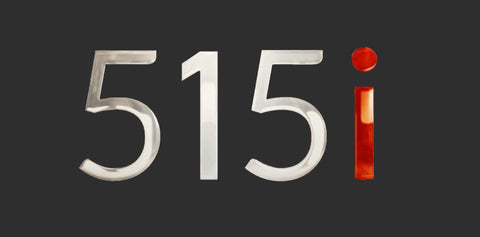With all the options available in the automotive world, eventually every build begins with one major decision. Build it stock, or build a restomod? Recently, the 515i team was faced with this exact same decision, and we must say, it was not easy. So this begs the question, is the customer always right?
The year is 1966. Uncle Gary goes down to the dealership and decides to pick himself up a beautiful 1966 Chevy Corvette convertible. Equipped with a Muncie 4-speed transmission and Chevrolet's beast of a big block, 427 cubic inches of Detroit iron that breathed through a 4-barrel carburetor and dual exhaust. Gary and Jackie enjoyed their Corvette as most people did those days with their now-prized classic muscle cars. The car gave them only 32,000 miles of fun until that sad day in 1973 when that 427 failed to start, then also failed to roll over. An attempt was made to diagnose, however, it was out of Gary's wheelhouse. Family members have told me that they asked about the car through the years, but Gary's responses were always vague and incomplete about why he didn't drive his Vette. The once beautiful King of the streets sat buried under chairs, bikes and tarps for 50 years.
Gary and Jackie grew old and eventually, sadly, passed away. This just happens to be where I come in. It starts with a phone call from a friend, "Uncle Gary passed away and there is a car in his garage. Can you come over and take a look?" Imagine my surprise when everything was moved and there sat a 66 Corvette convertible big block 4-speed. Now, it's not a coupe, but Chevy didn't make a single bad Corvette, especially when we are talking about the C2. I start to tear into it and I find the engine is locked up. Unfortunately, the last thing Gary did was pull all of the spark plugs out of it before giving up on it. Open combustion chambers and 50 years in Michigan DO NOT go well together. A quick borescope revealed 50 years of rust and calcium, and a mystery item in cylinder number 2. After staring at a grainy borescope screen for way too long, the decision was made to disassemble. You have to remember, the car was newly inherited, the future of the car was uncertain and neither party was all-in about spending over $100,000 on their new find to bring it back to life. Anyway, the passenger side cylinder head came off, and lying on top of the piston was the head of an exhaust valve. No damage to the bottom of the head, and only a small little indent on top of the piston. Whenever the valve broke, it did so at a low enough RPM to not be catastrophic. Had it not been for the 50 years of rot, it may have even been saved in its current condition. What saddened me is, to replace a cylinder head on this car back in 1973 may have only taken 4-6 hours from start to finish, a weekend and a case of beer with a buddy could have saved it. Flash forward 50 years and it needs a complete restoration. Everything was seized, nothing turned and there was 10 pounds of rust and scale where the car once sat. The confused and concerned faces quickly set in and the question became, what do we do with it?
So, you have a highly desirable classic muscle car, you have someone that knows how to bring it back to life, the only question is, how? To what degree do you modify to make it your own? Are you a purist where factory original is the only option? Are you a little less pure? Cheating a little bit; those polyurethane bushings in those factory control arms isn't really hurting anything, is it? That engine was okay from the factory but a new cam and massaging those cylinder heads really wake it up. Or, do you love the original body lines of those original cars but driving them keeps you on your toes and the very top of the line suspension would get bested by a 2012 Focus. The options were presented, every option, every degree of upgrades, from completely stock to a full blown SEMA build. What was decided? Well... somewhere just below full-blown SEMA build, we think.
The original 427 was kept, however, it was upgraded. Stock ranks, stock rods but ARP everything and Clevite 77 bearings. The compression was bumped slightly with the addition of forged pistons and a slight decking of the block and machining of the cylinder heads. The camshaft was upgraded with slightly more lift than stock and triple springs capped off with comp cams magnum roller rockers. We topped it all off with Fi Tech port fuel injection that should put us somewhere in the 530 horsepower range. The Muncie 4-speed was upgraded with new synchros and maximum load bearings. The countershaft was equipped with roller bearings and that old mechanical clutch was swapped out for hydraulic. The rear differential was bumped up to a 3.55 gear instead of the original 3.36 and the clutches were replaced. Now the fun begins.
Coil overs all the way around. Detroit speed double adjustable coil over suspension with rack and pinion steering up front. Van steel single adjustable in the back with offset trailing arms. Baer 14-inch, 6-piston brake kits on all four corners, while still maintaining the parking brake. After getting to the point of no return, the decision was made to add 1.5" flares to accommodate a 12-inch tire in the rear and a 10-inch wide tire up front. The original idea was factory, but stronger. But at some point, everything snowballed into a compete, full-blown resto-mod in every sense of the word, and I love it!
Restoring one of the cars to factory original is about a 2-year process, Our build is still underway as we now have to let the body settle for a bit after getting back onto the frame. Initial body work is done and the next step is flares and paint. The path has been picked, the parts ordered, decisions made. It may be too late for us, however I pose the question to you, did we make the right call? Is the customer always right?
I firmly believe there are complete unicorns out there that should never be touched or modified. Daytona Chargers, Hemi Cudas, the 250 GTO, real Yenkos, etc... A 66 coupe, by all means keep it original, I just don't think a 66 convertible is one of those unicorns. Call me jaded, call me numb to cars after so many years, call me wrong, that's okay. In this case, we have a client that inherited a family car and never plans on selling. It's a family member that will be passed down through the generations. In cases like this, I say the customer is always right.
A little word to the wise for people who don't have clients with the emotional attachment that I'm dealing with in this case though. Leave something for the purists out there. As many of you know, the time to acquire any desirable muscle car is right now. If you see it, grab it. You never know if the next time you drive pass your long lost friend, it might be the last. However, if what you are wanting to build is so insane that nothing is shared from the original vehicle, grab that straight 6 version, grab that unfinished project car that doesn't have a chance with it's current owner of getting back on the road. I'm all for the rest-mod, some of the best builds out there are resto-mods and the creativity and craftsmanship that goes into them is some of the most beautiful work I have ever seen. Rest-mods bring out the best in creativity and ingenuity and with the advancements in technology I can honestly say, the resto-mod is here to stay. Learn to appreciate both, from factory restorations to 1000 horsepower beasts - they are both amazing in their own ways. I believe there is plenty of room for both at the show!
I hope you enjoyed this blog, please let 515i.com be your go-to place for go-fast goodies and high performance parts.



1 comment
Such a hard decision. I guess it depends on what your trying to gain out of it. Do you do it for yourself? Are you doing it to buy and then sell it? Are you in love with the past elements of the vehicle or want a modern take out of it? I’m at a loss but am really looking forward to seeing what you guys do with it! Best of luck!